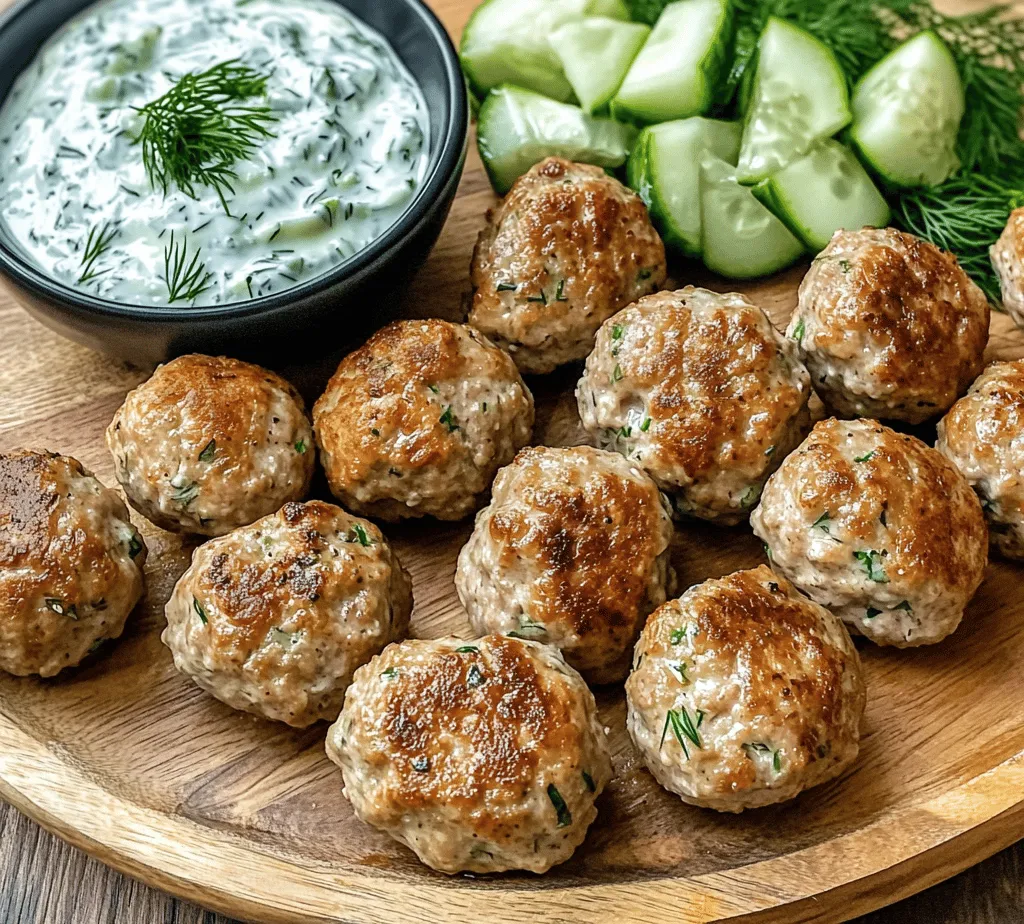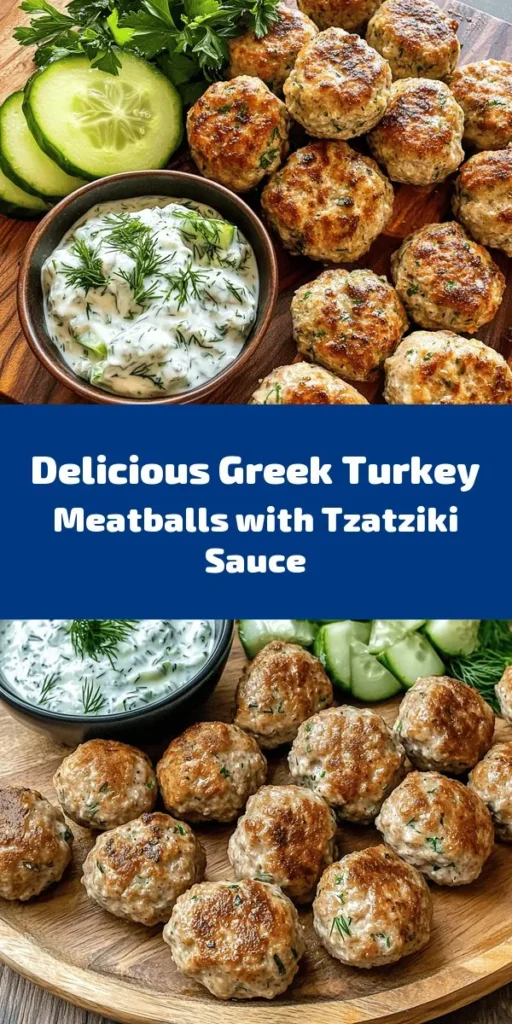In the realm of healthy and delicious meals, Greek Turkey Meatballs with Tzatziki Sauce stand out as a delightful option. Combining the lean protein of turkey with the vibrant flavors of Mediterranean cuisine, this dish not only satisfies your taste buds but also aligns with a nutritious lifestyle. Perfect for weeknight dinners, meal prep, or even special occasions, these meatballs are versatile and easy to prepare. In this blog post, we will delve into the origins of this flavorful dish, discuss its health benefits, and guide you through a step-by-step recipe to create your own delicious Greek turkey meatballs paired with a refreshing tzatziki sauce.
Understanding Greek Cuisine
Exploring the Mediterranean Flavors
Greek cuisine is a vibrant tapestry of flavors and ingredients, celebrated for its use of fresh produce, herbs, and high-quality meats. At the heart of this culinary tradition lies an emphasis on healthy eating, with dishes often featuring olive oil, vegetables, grains, and lean proteins. The Mediterranean diet, which has been linked to numerous health benefits, is characterized by its focus on whole foods and minimal processing, making it a beloved choice for health-conscious eaters.
Among the many beloved dishes in Greek cuisine, meatballs, known as Keftedes, hold a special place. These flavorful morsels are often enjoyed as appetizers or main courses and are typically seasoned with a blend of herbs and spices that reflect the region’s rich agricultural heritage. In Greece, Keftedes are often served with a variety of sauces, and one of the most popular accompaniments is tzatziki, a refreshing yogurt-based sauce that enhances the dish’s flavors while adding a cooling element.
The Greek turkey meatballs we’re exploring in this recipe are a modern twist on traditional Keftedes, substituting ground turkey for beef or lamb. This modification not only makes the dish lighter but also introduces a unique flavor profile that pairs beautifully with the accompanying tzatziki sauce. Together, these elements embody the essence of Greek flavors, offering a delightful taste of the Mediterranean.
Health Benefits of Turkey and Tzatziki
Nutritional Profile of Ground Turkey
When it comes to lean protein sources, ground turkey is a standout choice. This poultry option is low in fat and high in protein, making it an ideal ingredient for anyone looking to maintain a healthy lifestyle. A typical serving of ground turkey contains around 20 grams of protein, which is essential for muscle health, tissue repair, and overall bodily function. Additionally, turkey is rich in essential nutrients, including B vitamins (such as B6 and B12), iron, and zinc, which are vital for energy production and immune health.
One of the key advantages of using ground turkey in meatballs is its lower fat content compared to other meats. While traditional meatballs may be made with fatty cuts of beef or pork, turkey provides a leaner alternative without sacrificing flavor. This makes Greek turkey meatballs a heart-healthy option that can fit seamlessly into various dietary plans, including those focused on weight management or muscle building.
The Goodness of Tzatziki Sauce
Tzatziki sauce, a staple in Greek cuisine, is not only delicious but also packed with health benefits. The primary ingredient, Greek yogurt, is known for its high protein content and probiotics, which support digestive health and a balanced gut microbiome. Unlike regular yogurt, Greek yogurt is strained to remove whey, resulting in a thicker texture and concentrated flavor. This makes it an excellent base for sauces, dips, and dressings.
Cucumbers, another key component of tzatziki, add a refreshing crunch while being low in calories and high in water content. They are rich in vitamins and minerals, including vitamin K and potassium, making them beneficial for hydration and overall health. The addition of fresh herbs, such as dill or mint, not only enhances the sauce’s flavor but also provides additional nutrients and antioxidants.
Together, the combination of Greek yogurt and cucumbers in tzatziki creates a sauce that is not only tasty but also nutritious. It adds a creamy texture and tangy flavor to dishes, making it an ideal pairing for Greek turkey meatballs. This sauce not only complements the meatballs but also adds a cool contrast to the savory, spiced flavors of the turkey.
Ingredients Breakdown
Essential Ingredients for the Meatballs
To create the perfect Greek turkey meatballs, you’ll need a selection of essential ingredients. The star of the show is, of course, ground turkey. While you can use either dark or white meat turkey, many prefer the richer flavor of dark meat for meatballs. If you’re looking for alternatives, ground chicken or even plant-based meat substitutes can be used, though the flavor profile will differ slightly.
Next, breadcrumbs play a crucial role in binding the meat mixture together while providing a tender texture. You can opt for traditional white breadcrumbs, whole wheat, or gluten-free varieties depending on your dietary needs. For added flavor, incorporating grated Parmesan cheese not only enhances the taste but also helps with moisture retention, ensuring your meatballs remain juicy.
Fresh herbs and spices are vital for flavor enhancement. A blend of parsley, oregano, and garlic will give your meatballs that authentic Greek flavor. You might also consider adding a pinch of cinnamon or allspice for a unique twist. Don’t forget salt and pepper to taste, as they are essential for balancing the flavors in your meatball mixture.
Creating the Perfect Tzatziki Sauce
For the tzatziki sauce, you’ll need a few key ingredients to bring this refreshing dip to life. Start with Greek yogurt as the base; its creamy texture and tangy flavor are what make tzatziki so special. You’ll want to use plain, unsweetened Greek yogurt to avoid any unnecessary sugars.
Cucumbers are the next star ingredient. Be sure to select seedless cucumbers, such as English cucumbers, as they have fewer seeds and a thinner skin. This will create a smoother sauce. To prepare the cucumbers, grate them and then squeeze out excess moisture using a clean kitchen towel; this prevents the tzatziki from becoming watery.
Fresh herbs, particularly dill or mint, are essential for flavoring your tzatziki. These herbs not only add freshness but also bring a burst of vibrant flavor that complements the meatballs beautifully. A splash of lemon juice adds brightness and acidity, balancing the richness of the yogurt. Lastly, incorporating minced garlic will give your tzatziki that classic zing that pairs perfectly with the savory meatballs.
Variations and Substitutions
While the traditional recipe is delicious as is, there are endless possibilities for variations and substitutions. If you’re looking for a vegan option, consider using plant-based ground meat or lentils in place of turkey, and substitute the Greek yogurt with a vegan yogurt alternative made from coconut or almond milk. You can also add different spices or herbs to customize the flavor to your liking.
For those who enjoy a bit of heat, adding crushed red pepper flakes to the meatball mixture or incorporating jalapeños into the tzatziki can offer a delightful kick. Additionally, you can experiment with different dipping sauces or sides, such as hummus or roasted vegetables, to create a full Mediterranean-inspired meal.
Step-by-Step Recipe: Preparing the Meatball Mixture
Now that we’ve covered the ingredients and their health benefits, let’s dive into the step-by-step process of preparing Greek turkey meatballs. The key to achieving delicious meatballs lies in the careful mixing of ingredients and proper cooking techniques.
1. Gather Your Ingredients: Before you start, ensure all your ingredients are prepped and ready to go. This includes measuring out your ground turkey, breadcrumbs, Parmesan cheese, fresh herbs, and spices.
2. Combine the Meatball Ingredients: In a large mixing bowl, add the ground turkey, breadcrumbs, Parmesan cheese, minced garlic, chopped parsley, dried oregano, salt, and pepper. If you are using any additional spices, such as cinnamon, this is the perfect time to add them.
3. Mix Thoroughly: Using your hands or a spatula, gently mix the ingredients until just combined. Be careful not to overmix, as this can lead to tough meatballs. The goal is to have a cohesive mixture that holds together without being overly compact.
4. Form the Meatballs: Once your mixture is combined, use a cookie scoop or your hands to portion out the mixture into equal-sized meatballs, typically about 1 to 1.5 inches in diameter. This ensures even cooking. Place the formed meatballs on a baking sheet lined with parchment paper or lightly greased.
5. Chill the Meatballs: For best results, consider chilling the formed meatballs in the refrigerator for about 30 minutes. This helps them hold their shape during cooking and enhances the flavors as they meld together.
With your meatball mixture prepped and ready, you’ll be one step closer to enjoying a delicious meal that embodies the vibrant flavors of Greek cuisine. The next steps will involve cooking the meatballs to perfection and preparing the tzatziki sauce, which we’ll cover in the following section. Stay tuned for a delightful culinary experience that’s sure to impress family and friends alike!

Detailed Instructions for Mixing Ingredients
To begin crafting your Greek turkey meatballs, it’s important to ensure that your ingredients are well-combined. Start by gathering all your ingredients, which typically include ground turkey, breadcrumbs, minced garlic, chopped fresh herbs (like parsley and mint), shredded zucchini, an egg, and seasoning (salt, pepper, and dried oregano).
1. Combine Dry Ingredients: In a large mixing bowl, add the breadcrumbs, minced garlic, chopped herbs, dried oregano, salt, and pepper. Mix these dry ingredients together using a fork or your hands until they are evenly distributed. This step is crucial as it ensures that every meatball will have a consistent flavor.
2. Add Moist Ingredients: Next, add the ground turkey and shredded zucchini to the bowl. Using your hands, gently combine the turkey with the dry mixture. Be careful not to overmix, as this can lead to a tough texture. The moisture from the zucchini will help keep the meatballs juicy.
3. Incorporate the Egg: Crack an egg into the mixture. The egg acts as a binder, helping the meatballs hold their shape during cooking. Mix gently until the egg is just incorporated.
Tips for Achieving the Right Consistency
Achieving the right consistency for your meatball mixture is key to ensuring they hold together and remain juicy after cooking. Here are some tips:
– Texture Check: The mixture should be moist but not overly wet. If it’s too sticky, add a bit more breadcrumbs until you reach the right texture. Conversely, if it seems too dry, a splash of milk or broth can help.
– Chill Before Cooking: For best results, let the mixture rest in the refrigerator for about 30 minutes before forming the meatballs. This chilling period helps the flavors meld together and makes the mixture easier to shape.
Forming and Cooking the Meatballs
Techniques for Shaping Meatballs
Once your mixture has chilled, it’s time to form the meatballs. Here’s how to do it properly:
1. Use a Cookie Scoop: A cookie scoop or ice cream scoop is ideal for portioning out meatballs of uniform size. This ensures that they cook evenly. Aim for about a 1.5-inch diameter for each ball.
2. Shape with Your Hands: Lightly wet your hands to prevent sticking, and gently roll each portion into a ball. Avoid compressing them too tightly, as this can lead to dense meatballs.
3. Place on a Baking Sheet: Arrange the formed meatballs on a baking sheet lined with parchment paper. Ensure they are spaced out to allow even cooking.
Best Practices for Cooking to Ensure Juiciness and Flavor
There are several methods for cooking meatballs, but baking or pan-frying are the most popular for this recipe.
– Baking: Preheat your oven to 400°F (200°C). Bake the meatballs for about 20-25 minutes until they are cooked through and have a golden-brown exterior. Baking is a healthier option that allows excess fat to drip away.
– Pan-Frying: For added flavor, consider pan-frying the meatballs in a skillet. Heat a tablespoon of olive oil over medium heat, then add the meatballs in batches, turning them occasionally until they’re browned on all sides and cooked through (about 10-15 minutes).
Crafting the Tzatziki Sauce
The tzatziki sauce is a perfect accompaniment to your Greek turkey meatballs. This refreshing yogurt-based sauce complements the flavors of the meatballs beautifully.
Step-by-Step Guide to Mixing and Chilling
1. Prepare the Cucumber: Start by grating a medium cucumber. Squeeze out excess moisture using a clean kitchen towel or cheesecloth. This step is crucial to prevent the sauce from becoming watery.
2. Mix the Ingredients: In a medium bowl, combine the strained cucumber, Greek yogurt, minced garlic, lemon juice, olive oil, and chopped dill. Stir until all ingredients are well incorporated.
3. Season to Taste: Add salt and pepper to taste. For a bit of zest, consider adding more lemon juice or a dash of red wine vinegar.
4. Chill: Cover the tzatziki sauce and refrigerate for at least 30 minutes before serving. This chilling time allows the flavors to meld together beautifully.
Suggestions for Adjusting Flavor Intensity
If you prefer a stronger flavor profile in your tzatziki sauce, here are some modifications you can make:
– More Garlic: If you love garlic, feel free to add an extra clove or two, finely minced.
– Extra Lemon: For a more pronounced citrus flavor, add additional lemon juice or even some lemon zest.
– Herb Variations: Experiment with herbs like mint or even a touch of oregano for a different taste.
Serving Suggestions
Presentation Ideas for Greek Turkey Meatballs
When it comes to serving your meatballs, presentation can elevate the dining experience. Here are some tips:
– Plating: Arrange the cooked meatballs on a large platter. Drizzle with olive oil and sprinkle with fresh herbs for a pop of color.
– Garnish: Add lemon wedges and sprigs of dill or parsley around the platter for a fresh touch.
Pairing Options with Salads, Pita, or Grains
Greek turkey meatballs are incredibly versatile, and pairing them with the right sides can enhance your meal:
– Mediterranean Salad: Serve with a fresh Greek salad made of cucumbers, tomatoes, olives, and feta cheese.
– Pita Bread: Offer warm pita on the side for a delightful contrast in texture. You can even stuff the meatballs and tzatziki into the pita for a delicious sandwich.
– Grains: Quinoa or bulgur wheat seasoned with herbs can serve as a hearty base for the meatballs.
Utilizing Tzatziki Sauce Beyond the Plate
The tzatziki sauce isn’t just a condiment for meatballs; it can serve multiple purposes in your culinary repertoire:
– Dipping Sauce: Use tzatziki as a dip for fresh vegetables, pita chips, or even crispy falafel.
– Salad Dressing: Thin the tzatziki with a little extra lemon juice or water to create a creamy dressing for salads.
– Leftover Incorporation: If you have leftovers, use the tzatziki sauce in wraps, sandwiches, or as a flavorful addition to grain bowls.
Culinary Variations and Adaptations
Exploring Flavor Combinations
To keep your meatballs exciting, consider these flavor variations:
– Mediterranean Ingredients: Incorporate chopped sun-dried tomatoes or olives into your meatball mixture for added depth.
– Spice Levels: For a spicier kick, add red pepper flakes or crushed chili to the mixture. Adjust according to your preference.
Dietary Adaptations
Making this recipe accessible to different diets is easy:
– Gluten-Free Options: Use gluten-free breadcrumbs or ground oats as a substitute for traditional breadcrumbs.
– Low-Carb Variations: For a keto-friendly meal, you can skip the breadcrumbs altogether and use almond flour or crushed pork rinds in the mixture.
Conclusion
Greek Turkey Meatballs with Tzatziki Sauce offer a delicious and healthy meal option that is both easy to prepare and full of flavor. This dish not only allows you to enjoy the rich culinary traditions of Greece but also provides a nutritious alternative to heavier meatball recipes. By following this comprehensive guide, you can create a satisfying meal perfect for any occasion, whether it’s a family dinner or a gathering with friends. Embrace the flavors of the Mediterranean in your kitchen and enjoy the wholesome goodness of this delightful recipe.



